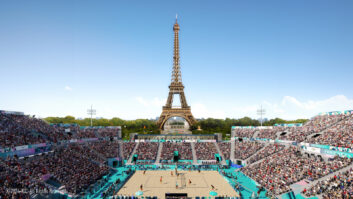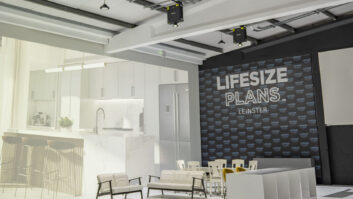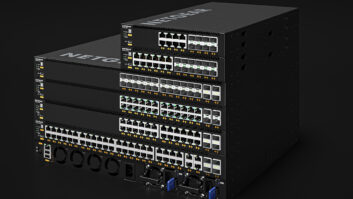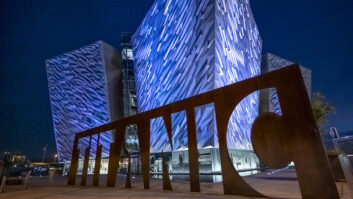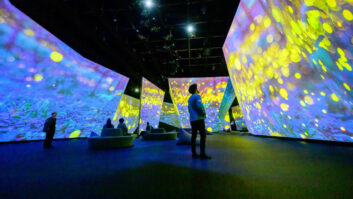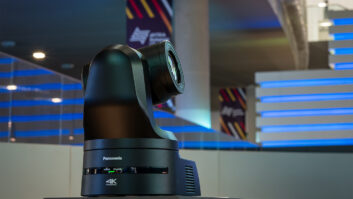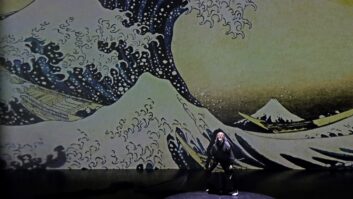During this year’s Milan Design Week, Panasonic exhibited a unique install to mark its 100th anniversary and also prefaced the company’s future direction with a couple of presentations. I was flown out early on the morning of 16 April along with a group of European journalists from across AV and adjacent industries to bear witness at the Pinacoteca di Brera in Milan, home of the Brera Academy of Fine Arts.
Milan Design Week is the collective name for the world’s biggest furniture showcase and exhibitions that runs in April each year. Now in its 57th year the event brings a sizeable chunk of central Milan to a standstill due to the interest and congestion it generates.
The concept for Panasonic’s exhibition was ‘Transitions’ and it signals the company’s move to become “not purely focused on creating objects, but moving in closer to people’s hearts.” The three areas that will be promoted going forward include ‘culture’, ‘living space’ and ‘community’, which the manufacturer says will generate new experiences and values.
On these areas, Shigeo Usui, director of Panasonic Design, explained: “Culture – we strongly believe in being a creative team that does not only focus on the usability and efficiency of products. We also focus on how these products fit into the culture of consumers’ lives, lifestyles and experiences.
“The next focus area is Living Space. Life should be considered as how we experience and feel as we flow through different living spaces, rather than simply about how products and spaces function.
“The last focus area is Community. We believe that our company should behave like a community existing as part of a bigger society. From now on, we aim to be a creative community that collaborates and co-creates with people, societies, brands and so on from all over the world.”
Air Inventions
Onto the company’s Milan exhibition – aptly named ‘Air Inventions’, the temporary installation includes a number of proprietary technologies from Panasonic, some you’d expect – 4K projection, and others you wouldn’t – air conditioning.
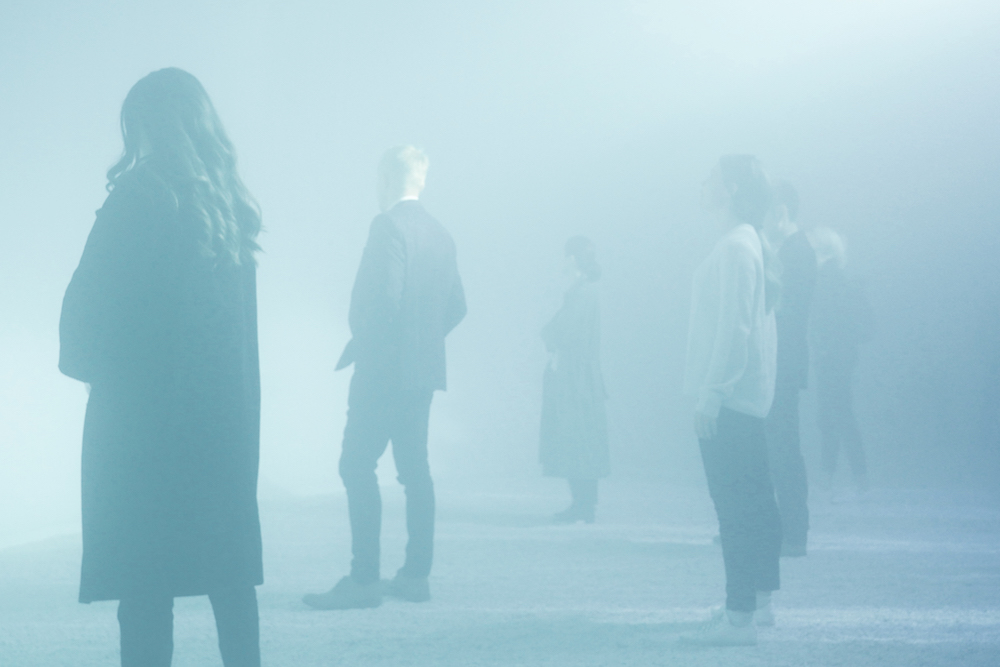
“In an era where diverse values co-exist, the role of design is dramatically changing,” said Usui. “Our ‘Air Inventions’ installation has been born out of our strong commitment to a new creative philosophy that focuses on the value of intangible experiences.”
‘Air Inventions’, which lasted around five minutes, engaged different senses with the 4K projection component providing stunning visuals, complemented by air purification technology. This created an otherworldly atmosphere within the dome unlike anything I have experienced. The result is an immersive and absorbing experience that leaves you feeling cleansed and refreshed.
The air dome is 20-metres in diameter and placed in the courtyard of the venue in the shape of a giant water-drop, although Pinacoteca di Brera director, James Bradburne, admitted many have said the shape more closely resembles a ball of mozzarella. Inside the dome structure, Panasonic aimed to create “the most beautiful and clean space in Milan” by utilising its latest air conditioning technology – ‘nanoe X’ air purification ionisation technology, and ‘silky fine mist’, another proprietary technology, which micronizes water with high-pressured air. In terms of the AV technology on show – to create the accompanying 4K projection mapping, two 27,000-lumen PT-RQ32K projectors were deployed along with ET-D3LEF70 fisheye lenses.
Developed by Panasonic, ‘nanoe X’ collects moisture from the air and applies a high voltage to create nano-sized particles of water. Highly reactive components, known as OH radicals are generated and these inhibit viruses and bacteria, remove odours from fabrics and inhibit allergens and mould. In this installation the technology is used to clean the air.
‘Silky fine mist’ uses compressed air to turn water into minute particles; it’s at low pressure removing the need for huge compressors. The size of the particles means that while there is a feeling of moisture in the air, you emerge from the dome dry. It has been developed as a viable city cooling technology (for events such as the Tokyo Olympics), and the low pressure prevents any resemblance to a quasi-human car wash. All in all a thoroughly pleasant experience and just what you need on a hot Milan afternoon. In addition the particles are used as a new screen for the projector with light cast on the mist.
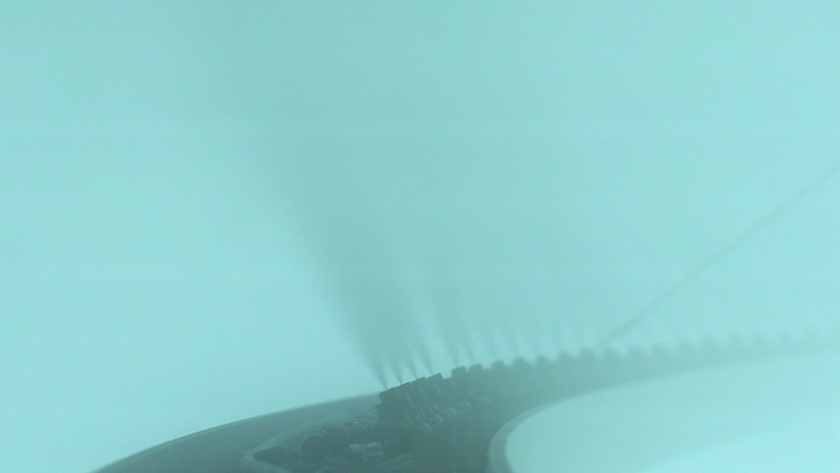
The ET-D3LEF70 fisheye lens expands the projected angle of view, which in combination with the high brightness PT-RQ32K projectors reduces the number of units needed when staging events in large spaces. As the focus depth is large and focus adjustment is rarely necessary it can also be used in performance spaces other than domed theatres.
Roadmap
Following the installation, press were invited to an on-site press conference, which described a number of the technologies featured in ‘Air Inventions’, and also revealed more about the direction Panasonic will take in the future.
Laurent Abadie, CEO and chairman of Panasonic Europe, highlighted the need for the company to continue to adapt and provide new solutions. “One of our efforts will be to strengthen our design approach to continue to innovate now and in the future,” he stated. “I’m very proud that our determination to keep adapting and changing is being expressed here in our exhibition at the world’s biggest design festival, Salone Milano.”
To summarise the new approach, Abadie said: “This year, we’ve chosen the theme of ‘Transitions’ to reflect our design team’s determination to be flexible, adaptable and respond to the unprecedented changes we’re seeing in society and the wider world today.
“In this age of diversity, people are questioning and challenging what is most valuable to them. It’s no longer all about physical possessions, but about experiences, feelings and wellbeing too.
“We are challenging ourselves to meet these changing needs, combining the 100 years’ experience we have in creating innovative products, with an appreciation of these emerging ‘invisible’ values that consumers seek. This is expressed in our exhibition here at Salone Milano.”
On Panasonic’s exhibit at this year’s event, Usui commented: “We purposely avoided designing physical things and instead designed the experience, which was fulfilled by creating ‘the most pure air in Milan’ featuring Panasonic’s latest technology ‘nanoe X’ and ‘Silky fine mist’.”
The second and final day of the trip consisted of a presentation and solutions showcase by Michael Pullan, European PR Manager for Panasonic. He began by revealing, on 1 April the company launched a new retail division for the UK, France and Germany. The motivation behind this development is to try and revitalise the high street, which has been severely affected by the rise of e-commerce. However, Panasonic firmly believes the physical store can still be a great asset for a lot of retailers if they make it work, and the company’s expertise in the Internet of Things/connected solutions can be a catalyst for this.
The solutions being introduced fall under a new connected store and omnichannel approach. Among the solutions being trialled are 360-degree shopper analytics that utilise existing security infrastructure to provide customer analytics. Other solutions include real-time out of stock management (using CCTV analytics), and electronic shelf labelling.
The Milan event showcased a combination of technology that created a singular experience and the company’s plans for a more experience-based model is something the industry as a whole has been highlighting. AVIXA (formerly InfoComm) rebranded last year to emphasise this point and a growing number of companies have stated the necessity for creating experiences and not just selling ‘boxes’. All this gives Panasonic every chance of making its next hundred years as innovative as its first.
